Ready to transform your garden into a mesmerizing haven of roses? Here are some top-notch ideas to help you create a rose garden that’s not just a feast for the eyes but a sanctuary for your soul. Whether you’re a seasoned gardener or a budding rose enthusiast, these tips will guide you in cultivating a space where elegance meets simplicity.
1. Combine different types of roses
Mixing various types of roses, like hybrid teas, groundcover drifts, and shrub roses can create a visually captivating garden with an extended blooming period. Here are some different methods for mixing different classes:
Layer by height
Plant taller hybrid tea roses in the back, medium-sized shrub roses in the middle, and groundcover drift roses in the front. This tiered approach ensures each variety is visible and contributes to the overall aesthetic.

Color coordination
Choose roses with complementary colors. For instance, a palette of pinks, reds, and whites can create a harmonious look. Contrasting colors, like yellow drift roses against deep red hybrid teas, can also add visual interest.
Bloom synchronization
While hybrid teas typically have distinct bloom cycles, many shrub and groundcover roses offer continuous blooms. Choose hybrid teas with different estimated bloom times, and fill the area in with longer-blooming shrubs and groundcover cultivars. This combination ensures that the other varieties continue to provide color when the hybrid teas are between blooms.
Texture variation
Different rose types offer varied foliage textures, adding another layer of visual interest. The glossy leaves of hybrid teas contrast nicely with the often denser foliage of shrub roses. You may also wish to include species or wild roses for their decorative autumn rose hips.
Use for different purposes
Hybrid tea roses are excellent for cutting gardens due to their long stems and large blooms. In contrast, groundcover and shrub roses excel in landscaping, providing a lush, full look and often enhanced disease resistance.
Plant the shrub and groundcover roses where they will enhance curb appeal or backyard beauty. Plant the hybrid teas where they are easy to access for cutting and get lots of sun to promote flowering.
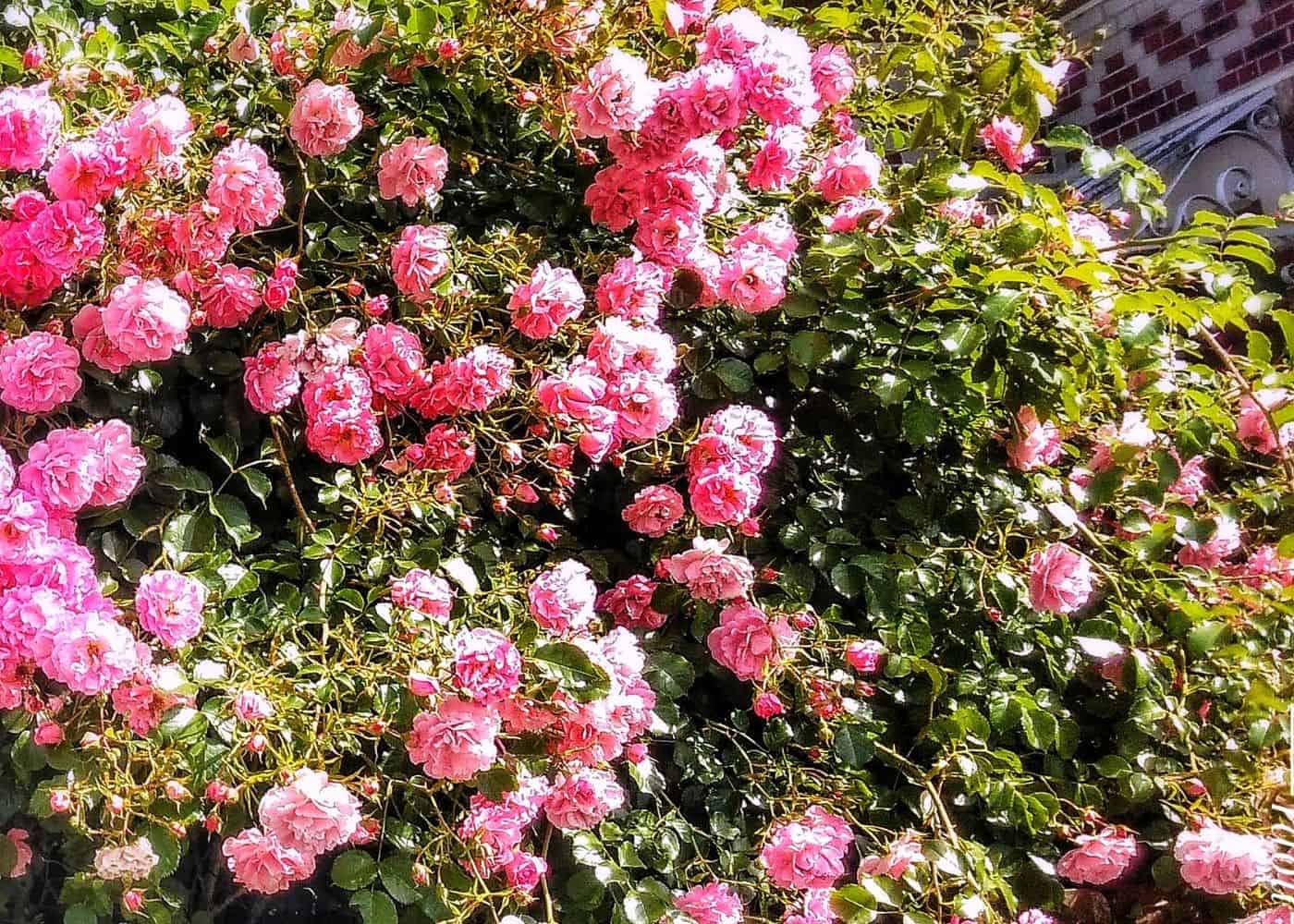
2. Create a hedge of rose bushes
Roses can be a fantastic choice for creating a living hedge that adds both beauty and privacy to your garden. Roses offer a unique combination of lush foliage and vibrant blooms, making them a functional decorative element.
To create an effective rose hedge, it’s crucial to plant the roses closely – about 18 to 24 inches apart. This ensures they grow together and form a dense barrier. Pruning is also key in maintaining the shape and health of your rose hedge. Regular pruning, preferably in early spring, encourages new growth and helps maintain the desired height and width.
Certain types of roses are more suited for hedging due to their growth habits and hardiness. Floribunda and shrub roses are excellent choices for hedges because of their dense growth and continuous flowering. Some specific varieties to consider include ‘Iceberg’ (known for its prolific white blooms and disease resistance) and ‘Knock Out’ series cultivars.
For a taller hedge, the ‘New Dawn’ climbing rose is a great option. It’s vigorous, offers abundant pink flowers, and is known for its disease resistance. On the other hand, for lower hedges, ‘The Fairy’ rose, a polyantha variety, provides a lush spread of small, pink blossoms.

3. Grow climbing roses up an arch
While many archways are beautiful, they can be made even lovelier using roses. To grow climbing roses up an arch, start by choosing a suitable location. Climbing roses need at least 6 hours of sunlight daily and well-drained soil.
Quite a few climbing rose cultivars are available that work well for archways. I have a climbing ‘Eden’ rose (light pink) that I adore. Other popular climbing varieties include ‘New Dawn,’ ‘Cecile Brunner,’ and ‘Zephirine Drouhin.’
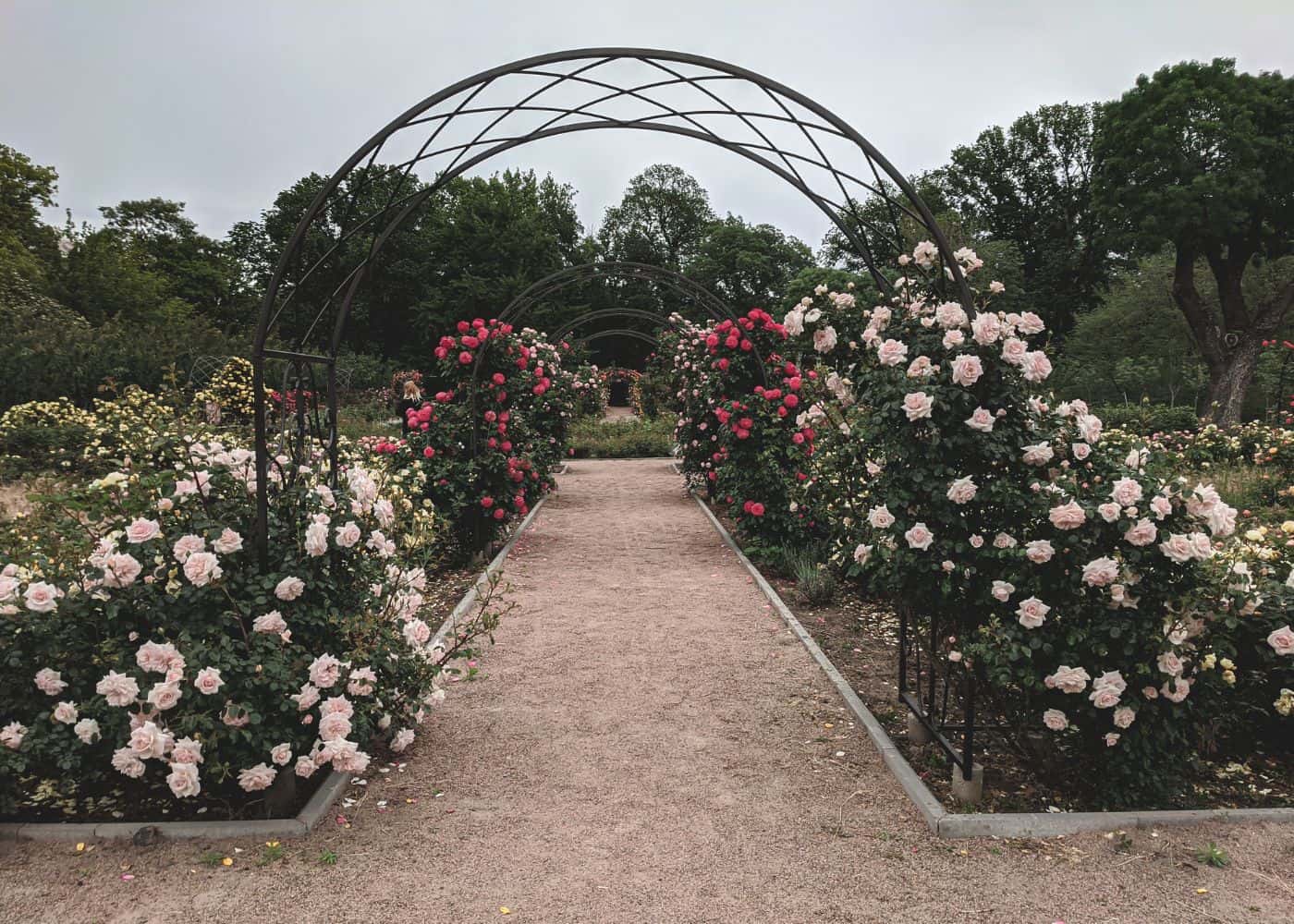
When planting, space the roses about 18 to 24 inches away from the base of the arch to allow enough room for root growth. Train the young canes of the rose by gently bending and tying them to the arch. Horizontal training encourages more lateral growth, leading to a fuller look and more blooms.
As the rose grows, continue to tie the canes, aiming for even coverage over the arch. Regular pruning, ideally in late winter or early spring, is crucial. Prune to remove dead or diseased wood and to shape the plant. Keep the base of the plant mulched and well-watered, especially during dry spells.
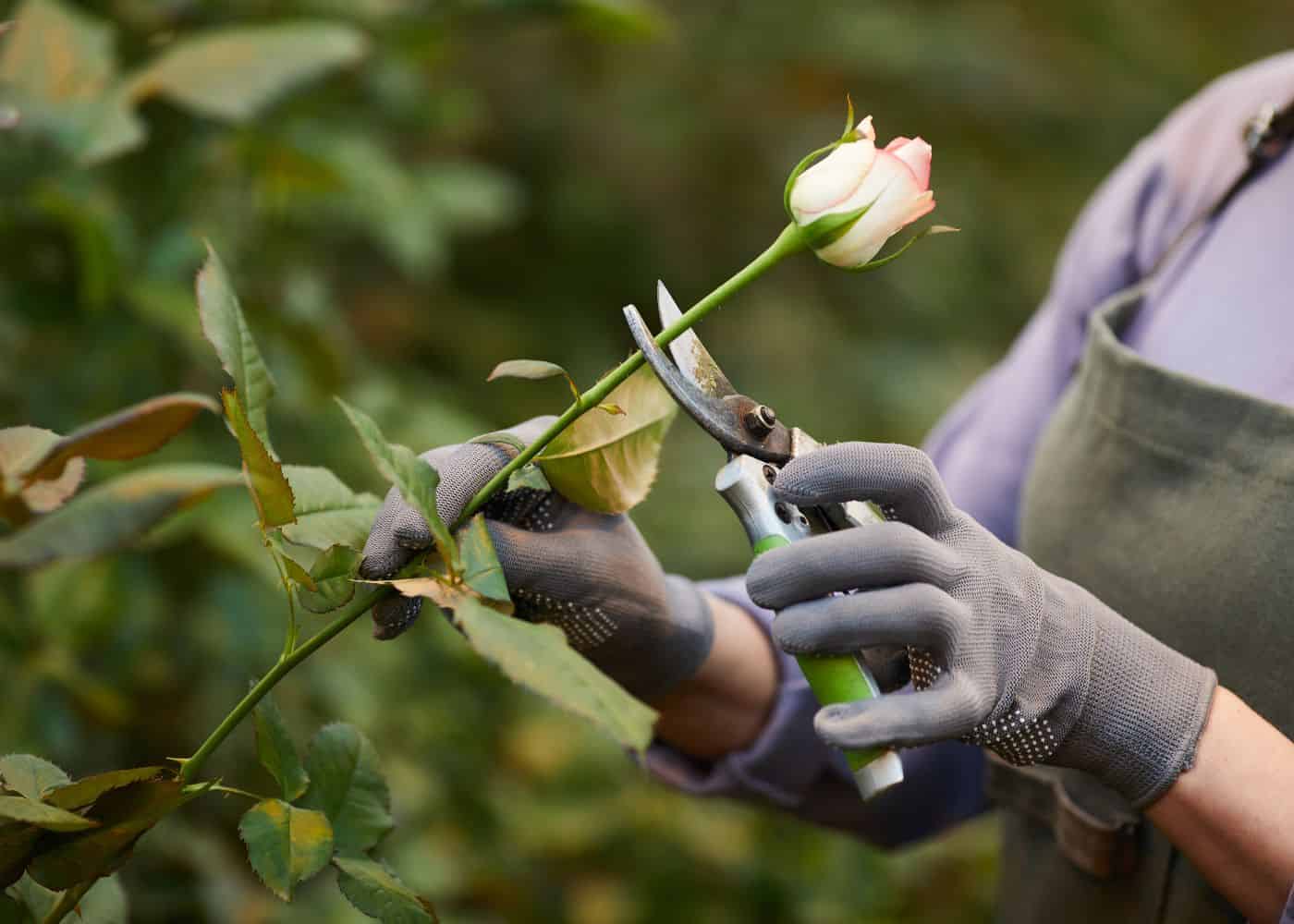
4. Plant a rose cutting garden for fresh bouquets
Dedicate a spot in your garden for fresh bouquets of flowers. For the most productive cutting garden, select a sunny spot, as roses thrive in at least six hours of direct sunlight daily.
When choosing rose varieties, opt for those known for their long stems and extended vase life. Hybrid tea roses, with their long, sturdy stems and large blooms, are a popular choice for cutting. Floribunda roses are also suitable due to their abundant flowers.
Prepare the soil by ensuring it’s well-drained and rich in organic matter. Incorporate compost or well-rotted manure to improve soil fertility. Plant the roses about 2 to 3 feet apart to allow enough space for growth and air circulation, which is crucial for preventing disease.
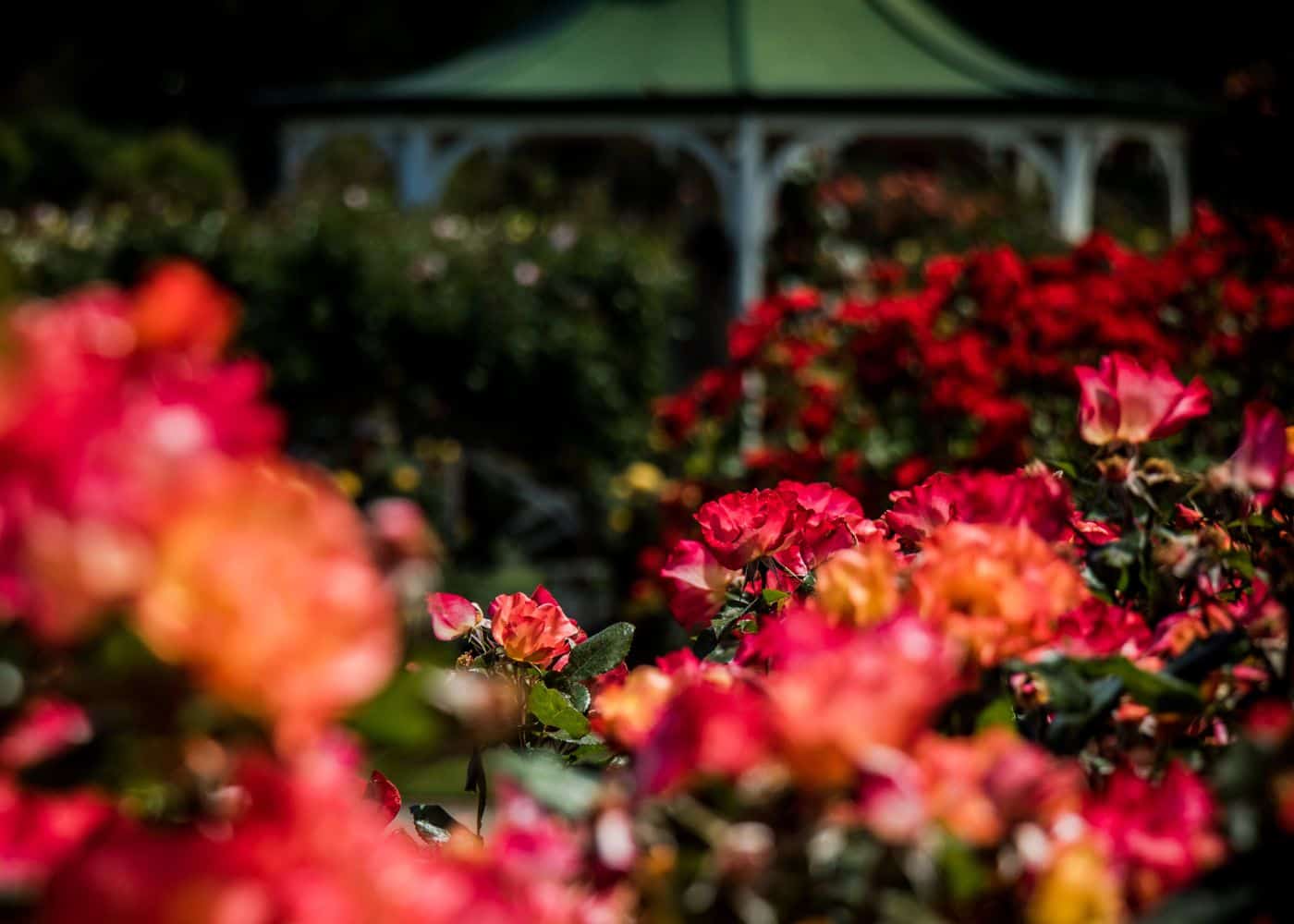
Once planted, establish a regular watering schedule, keeping the soil consistently moist but not waterlogged. A drip irrigation system is ideal as it delivers water directly to the roots and keeps the foliage dry, reducing disease risk.
To extend the vase life of your cut roses, cut them early in the morning when their water content is highest, and immediately place the cut stems in water. Cut the stem at a 45-degree angle using sharp, clean pruning shears to increase the surface area for water uptake. Strip the leaves that will be below the waterline to reduce bacterial growth.
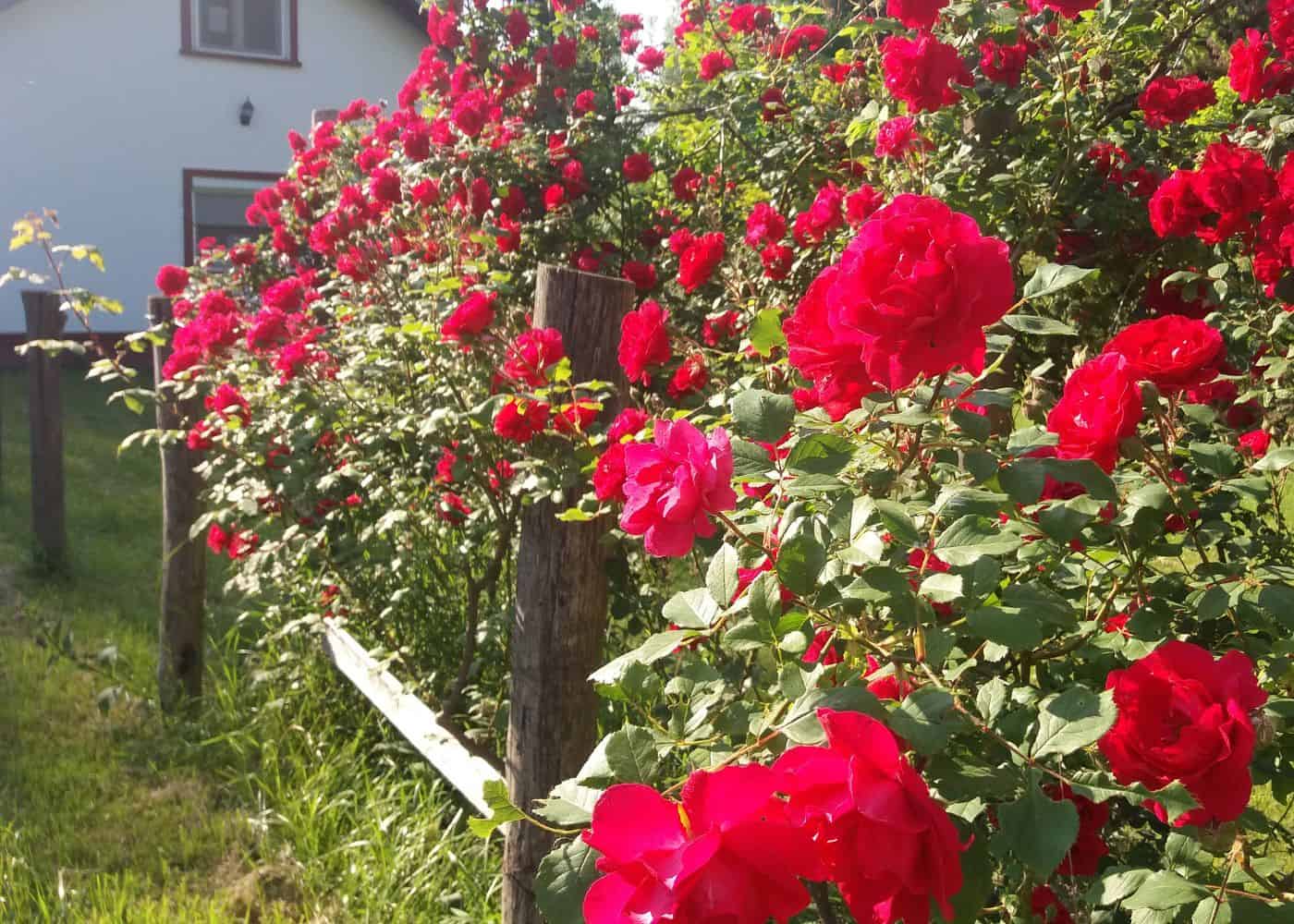
5. Plant roses for a wildlife garden
Wild rose species can provide food for wildlife in your area. The brightly colored flowers grow well in the spring and summer months, providing a food source for pollinators like bees. The flowers are followed by autumn hips, which are also edible by many beneficial species.
Choose open, single-petal rose varieties to include rose plants in a wildlife-friendly garden. These roses provide easier access to pollen and nectar for pollinators like bees and butterflies. Species roses are excellent choices. Planting these roses alongside other pollinator-friendly plants such as lavender, salvia, and echinacea can create a diverse habitat that attracts various pollinators.

To attract birds, consider planting roses that produce large hips, like the dog rose (Rosa canina) or the rugosa rose (Rosa rugosa). Rose hips are a valuable food source for birds, especially in fall and winter. Place bird baths or feeders near the roses to provide birds with water and additional food. This creates a welcoming environment for them.
In addition to plant selection, avoid using pesticides in your garden. Pesticides can harm beneficial insects and birds. Opt for organic gardening practices to maintain a safe and healthy habitat for wildlife. Regularly adding compost to the soil can improve its health and make your garden more attractive to earthworms and other beneficial organisms.
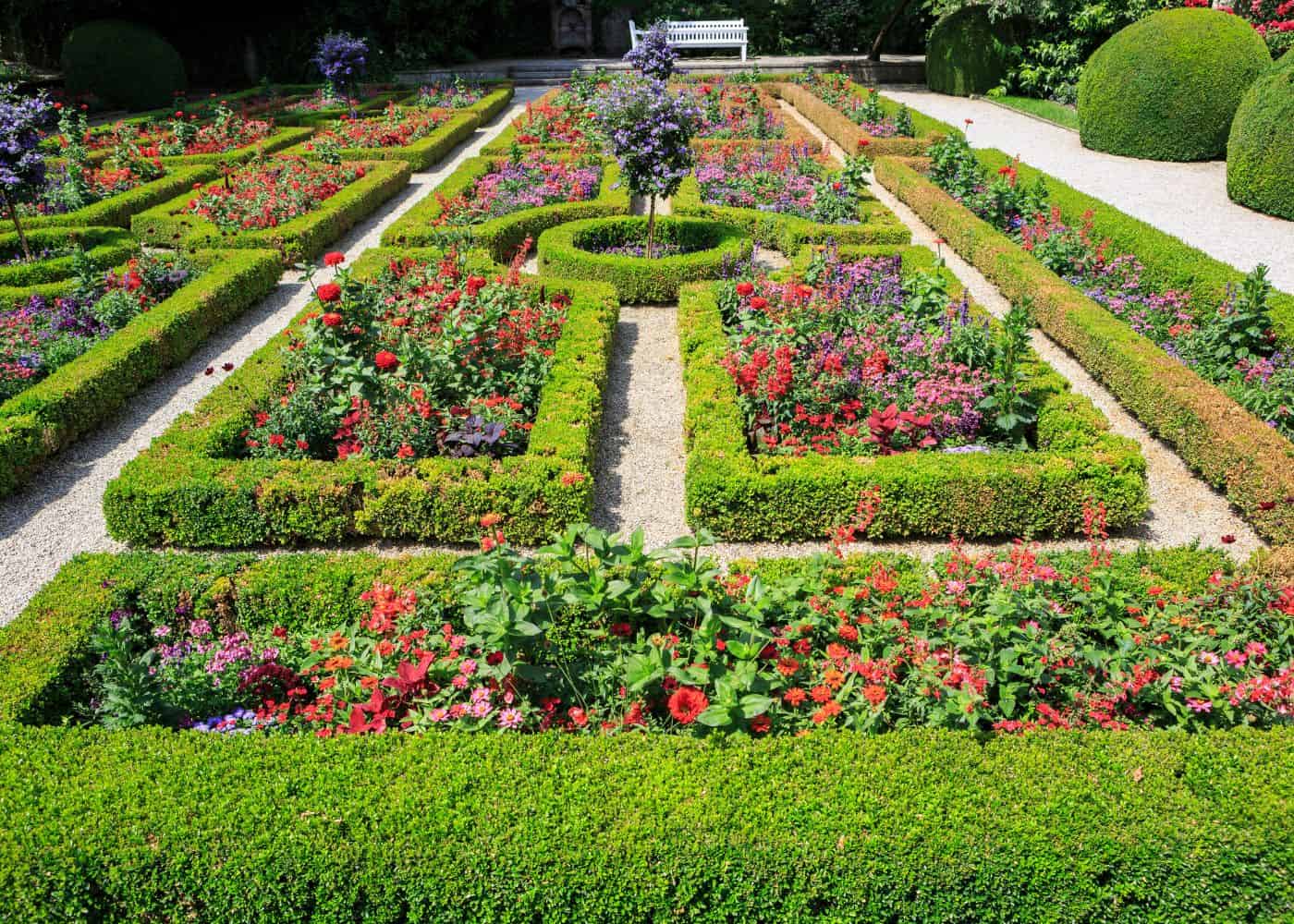
6. Design a formal rose garden
Roses lend themselves very well to formal garden design. If you have the time required to keep up with this type of landscaping, the result can be absolutely magnificent.
A formal rose garden typically features a symmetrical design. Consider a central focal point, like a fountain or statue, with rose beds radiating out or arranged in a geometric pattern, such as squares or circles.
Choose roses that offer a formal appearance. Hybrid tea roses, with their classic, single-stemmed blooms, are ideal. Newer English shrub roses like David Austin cultivars are a lower-maintenance option. Select a color palette that complements the garden’s theme – often monochromatic or featuring two to three coordinated colors.
Ideally, use materials like gravel, brick, or stone to incorporate straight, well-defined pathways. These paths provide access and contribute to the garden’s formal structure. Add classical garden elements like urns, benches, or an arbor. These accents enhance the formal feel and provide places to sit and enjoy the garden.
Use boxwood hedges to edge the rose beds. They provide a crisp, green border that contrasts beautifully with the roses. Keep the hedges neatly trimmed to maintain a formal appearance. The height of the boxwoods should be shorter than the roses when the roses are in bloom.

7. Pair pink roses with a white picket fence
Pink roses peaking through a classic white picket fence is one way to create a charming and picturesque exterior. And fortunately, this look is not difficult to achieve.
Choose a traditional white picket fence that’s sturdy and weather-resistant. The height can vary, but typically, picket fences are around 3 to 4 feet tall. Ensure it’s properly installed and spaced to allow room for roses to weave through.
For the classic look of pink roses peeping through the fence, choose varieties that are known for their climbing or sprawling habits. Good choices include ‘Eden,’ ‘New Dawn,’ ‘Strawberry Hill,’ or ‘Cecile Brunner.’ These varieties can be trained to grow through and over the fence.
Plant the roses 8-12 inches away from the base of the fence. Planting on either side of the fence can create a fuller look, but may not be possible if there is a sidewalk beside the fence.
As the roses grow, gently guide them through and around the pickets. You can use soft ties to secure the canes to the fence, encouraging them to grow in the desired direction. Be careful not to damage the canes when tying them.
Regularly prune the roses to maintain their shape and encourage new growth. This will also help keep the roses healthy and blooming throughout their season. Deadhead spent blooms to encourage more flowers.
For an even more picturesque scene, consider underplanting with low-growing perennials or annuals in complementary colors, like whites or purples. Keep both the roses and the fence well-maintained. Repaint the fence as needed to maintain its crisp white appearance.
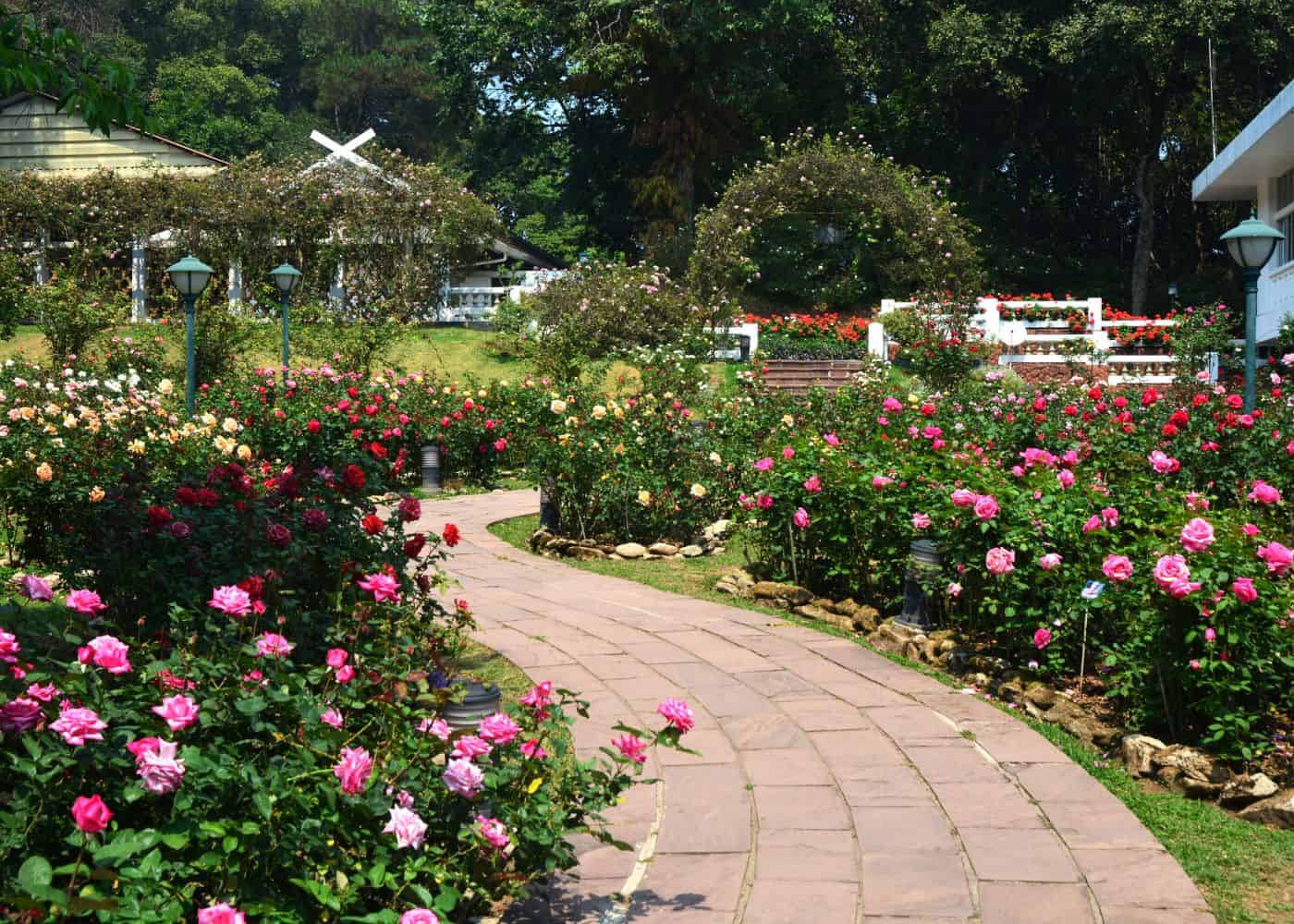
8. Create a rose walk
A rose walk is a delightful pathway surrounded by ornamental rose cultivars that are meant to be enjoyed while on the plant (rather than cut for bouquets). There are a number of various ways to arrange the plants along the walkway.
One method is a color progression. Arrange roses in a way that creates a color gradient along the pathway. Start with white or pale roses and gradually transition to deeper colors, like pinks, reds, and purples. This creates a visually striking effect.
Height variation can also make the walk more engaging. Alternate between taller and shorter cultivars to add visual interest. Place taller varieties like hybrid teas or grandifloras intermittently with shorter floribundas or miniature roses.
You can also combine different flower sizes. Mix roses with large, showy blooms alongside varieties with smaller, clustered flowers. For example, intersperse large-blooming hybrid teas with clusters of floribunda roses. The contrast in bloom size adds another layer of interest.
Choose varieties that bloom at different times or have extended blooming periods. This ensures that there’s always something in bloom along the path, keeping it attractive throughout the growing season.
One popular method is to group roses by themes, such as David Austin roses, modern hybrids, or roses named after famous individuals. Each section can tell a story or represent a particular aspect of rose breeding history.
Use attractive, durable labels for each cultivar. Include the rose’s common name, Latin name, and a brief description or interesting fact about it. This educates visitors and adds an informative element to the rose walk.
By thoughtfully arranging different rose cultivars along a pathway with these considerations in mind, you can create a rose walk that is not only visually captivating but also an immersive experience in the diversity and beauty of roses.
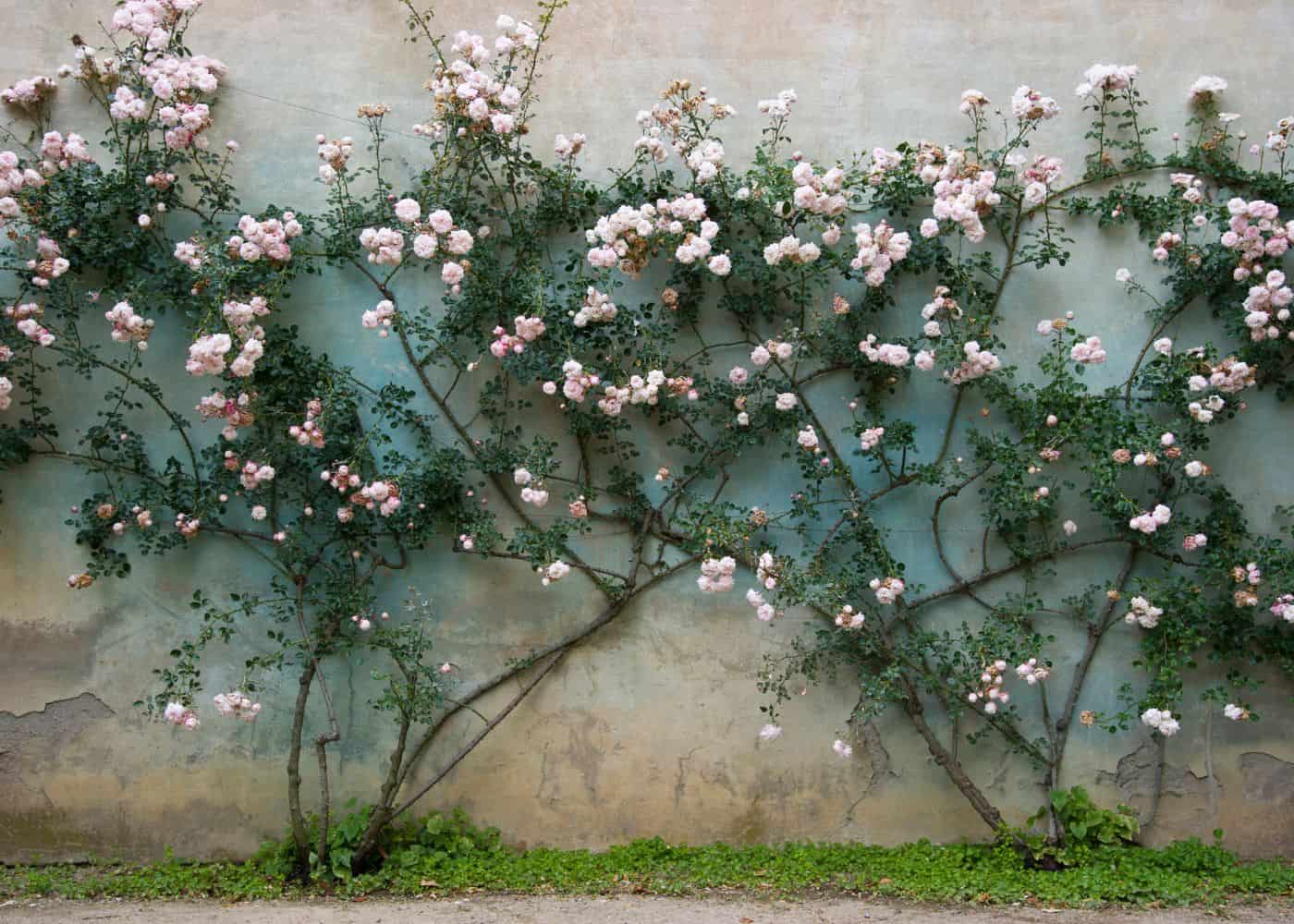
9. Grow climbing roses up a wall
Select climbing rose varieties that are known for their ability to climb and cover walls. Look for vigorous growers with a good track record of health and bloom production. As for arches and fences, climbing varieties like ‘New Dawn’, ‘Eden’, or ‘Zephirine Drouhin’ are excellent choices.
Ensure the wall is in good condition and can support the weight of climbing roses. If necessary, repair any cracks or damage. It’s also a good idea to paint or treat the wall as needed, as it will be difficult to do so once the roses are established.
Climbing roses need support to grow against a wall. Install trellises, wires, or eye hooks and wire systems. Space wires or trellises about 12 to 18 inches apart horizontally. The support should be sturdy and weather-resistant.
Plant the roses about 8-12 inches away from the wall to allow room for root development and air circulation. As the roses grow, gently tie the canes to the support system with twine. Aim to train the canes horizontally or diagonally; this encourages more lateral growth and leads to more blooms.
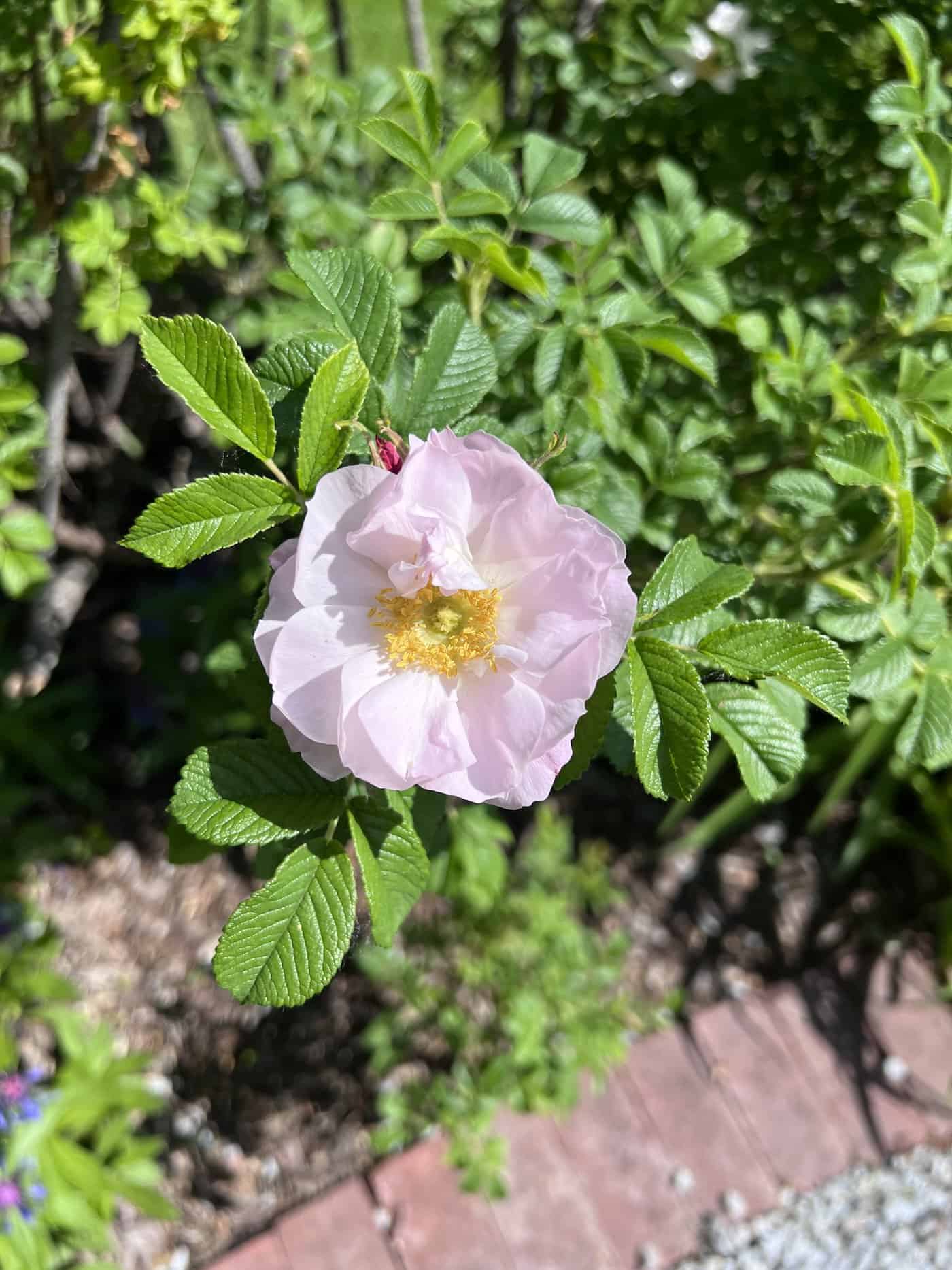
10. Create a heritage rose garden
A heritage rose, often referred to as an “old rose” or “antique rose,” is a variety that existed before 1867. That’s the year when the first hybrid tea rose, ‘La France,’ was introduced. These roses are prized for their rich history, unique fragrances, and diverse forms.
To find heritage rose plants for your space, look for nurseries that specialize in old roses. These nurseries often have a wide variety of heritage roses and can provide valuable advice on their care. Connect with local rose societies or gardening clubs, as members often share cuttings or have knowledge about where to find these roses.
Planting a heritage rose garden is similar to planting most other rose gardens. Choose a sunny location with at least six hours of direct sunlight daily. Heritage roses thrive in well-drained soil rich in organic matter. Amend the soil with compost or aged manure to improve fertility and drainage.
Give each rose ample space for air circulation. Heritage roses can vary greatly in size, so adjust spacing accordingly, typically 3-6 feet apart. Apply a layer of mulch around the plants to retain moisture, suppress weeds, and regulate soil temperature.
Label each rose with its name and date of introduction if known. A heritage rose garden is not just a collection of plants; it’s a living history of the rose through the ages.






